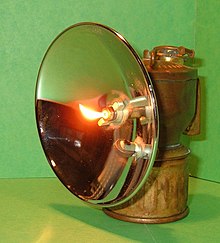History and Mechanism
– Thomas Willson discovered an efficient process for creating calcium carbide in 1892.
– The industrial revolution in chemistry was aided by the manufacture of calcium carbide.
– Domestic lighting with acetylene gas was introduced in 1894.
– The first carbide bicycle lamp was patented in 1900.
– Gustaf Dalén invented the Dalén light in the early 1900s.
– A mining or caving lamp has a generator and an upper reservoir.
– Water is controlled to drip into the chamber containing calcium carbide.
– The production of acetylene gas is controlled by the rate of water flow.
– Carbide lamps have reflectors to project the light forward.
– The reaction of carbide with water produces heat.
Uses and Lighting Systems
– Carbide lighting was used in areas without electrification in the United States.
– Early automobiles used carbide lamps as headlamps.
– Acetylene lamps were used on riverboats for night navigation.
– Carbide lamps are still used in recreational caving excursions.
– Carbide lamps were favored for their durability and quality of illumination.
– Carbide lighting used calcium carbide pellets and water to produce acetylene gas.
– The gas was piped to lighting fixtures inside the house.
– Carbide lighting was inexpensive but prone to gas leaks and explosions.
– Acetylene lamps were used for night navigation on riverboats.
Caving
– Carbide lamps were used by early caving enthusiasts before electric lights.
– Some cavers still prefer using carbide lamps for their durability and illumination.
– Carbide lamps were favored for long caving explorations without access to electricity.
– The heat from the lamps can be used to warm the hands and body.
– Carbide lamps are sometimes called ‘stinkies’ due to their odor.
Advantages and Applications
– Carbide lamps have a high light output, making them suitable for illuminating large areas.
– They are resistant to wind and weather, making them ideal for outdoor use.
– The light produced by carbide lamps is steady and does not flicker.
– These lamps do not require batteries or electricity, making them self-sufficient.
– Carbide lamps are relatively low-cost and easy to maintain.
– Carbide lamps were widely used in mining operations to provide illumination in underground tunnels.
– They were also used by cavers for exploring caves and underground passages.
– Outdoor enthusiasts such as hikers and campers used carbide lamps for lighting during nighttime activities.
– Some railroad workers used carbide lamps for signaling and communication.
– Carbide lamps were even used in early automobiles as headlights.
Safety Considerations and Decline
– The production of acetylene gas in carbide lamps can be hazardous if not handled properly.
– The lamps should be operated in well-ventilated areas to prevent the accumulation of gas.
– It is important to regularly check the water level and add water as needed to maintain gas production.
– Carbide should be stored in a cool and dry place to prevent decomposition.
– Proper protective gear, such as goggles and gloves, should be worn when handling carbide and operating the lamps.
– The invention of electric lighting and batteries led to the decline of carbide lamps.
– Carbide lamps are now primarily used for historical reenactments and collectors’ items.
– The use of carbide lamps in mining and caving has been largely replaced by modern LED lights.
– Despite their decline in practical use, carbide lamps hold a significant place in the history of portable lighting.
– Many enthusiasts and collectors appreciate the craftsmanship and nostalgia associated with carbide lamps. Source: https://en.wikipedia.org/wiki/Carbide_lamp
A Carbide lamp or acetylene gas lamp is a simple lamp that produces and burns acetylene (C2H2), which is created by the reaction of calcium carbide (CaC2) with water (H2O).

Acetylene gas lamps were used to illuminate buildings, as lighthouse beacons, and as headlights on motor-cars and bicycles. Portable acetylene gas lamps, worn on the hat or carried by hand, were widely used in mining in the early twentieth century. They are still employed by cavers, hunters, and cataphiles.
